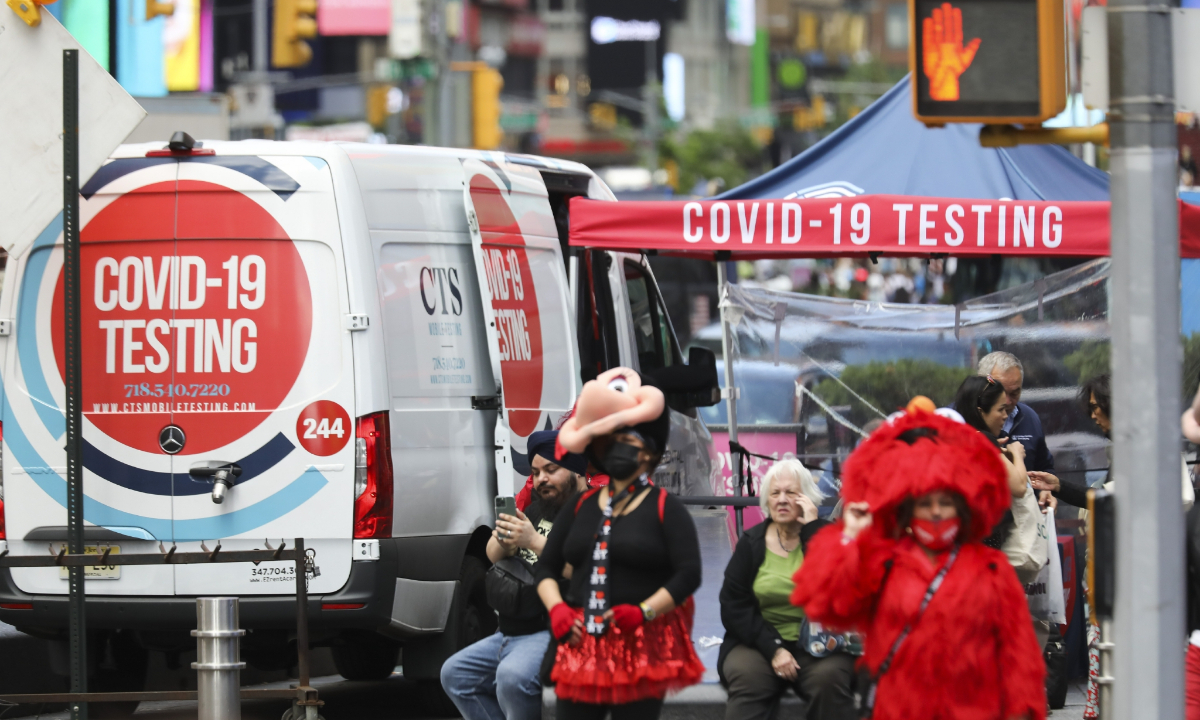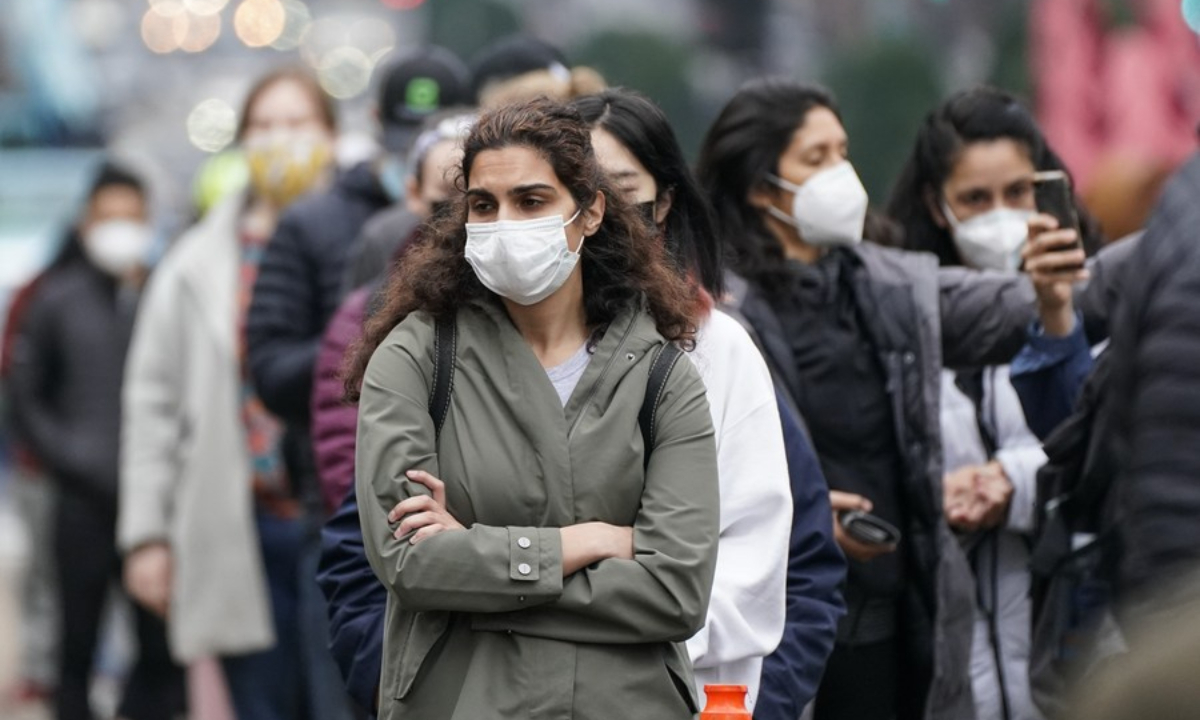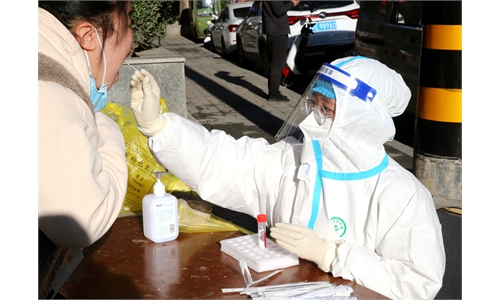Long COVID exposes long-term, irreversible challenges of ‘lying flat’ approach, may lead to innovation and economic decline

A COVID-19 testing site is seen on Times Square in New York, the United States, May 17, 2022. Photo:Xinhua
The increasingly prominent long-lasting effects of infections with COVID-19 have once again exposed the long-term and irreversible challenges of the "lying flat" approach in combating COVID-19, as adopted by many Western countries, and Chinese observers said that long COVID is likely to result in growing pressure on social and medical resources, the labor force shrinking, innovation declining and economic downturn in the long run.
According to a new research in Scotland, 6 percent of the 31,486 people who had had symptomatic infections felt they had not recovered at all, while 42 percent reported feeling only partially recovered between six and 18 months following infection.
The study, which has been published in Nature Communications on Wednesday, said some persistent symptoms include breathlessness, chest pain, palpitation, and confusion from six to 18 months later.
Those patients also experienced elevated risks of more than 20 other symptoms relating to the heart, respiratory health, muscle aches, mental health and the sensory system, the New York Times reported.
Jill Pell, a professor of public health at the University of Glasgow who led the research, said the findings reinforced the importance of offering support to long COVID patients that extends beyond health care and also addresses needs related to jobs, education, poverty and disability, according to the New York Times report.
In the US, a recent survey by US Centers for Disease Control and Prevention showed that 81 percent of the nearly 24 million American adults who had long COVID are seeing activity limitation, and 25 percent of them suffer significant activity limitation.

People line up to receive COVID-19 test in Washington, DC, the United States, on Dec 30, 2021. Photo:Xinhua
According to the World Health Organization (WHO), it's estimated that 10 to 20 percent of the people who fully recovered from COVID-19 have developed long COVID. And in the WHO's European region, at least 17 million people experienced long COVID in the first two years of the pandemic, and millions may have to live with it for years to come, the WHO said.
Long COVID, although not widely reported in China, has drawn widespread concern, after Wu Zunyou, chief epidemiologist at the Chinese Center for Disease Control and Prevention, mentioned it on Thursday in explaining why China has to stick to its current zero-COVID policy, instead of learning from the West to "lie flat."
Wu said that some long COVID symptoms included fatigue, trouble in concentrating, difficult breathing, headache, dizziness, depression and anxiety, which can last for weeks, months or even longer, and the best way to prevent long COVID is to prevent infection from the virus. He stressed that a dynamic zero-COVID policy is an important measure to prevent COVID-19 infections.
His remarks soon made it to the hot topic list on Chinese social media on Friday, with some netizens commenting that the zero-COVID policy is the only way out as it prevents people from getting not just the acute symptoms of COVID-19, but also its long-lasting and probably permanent effects to health.
Chinese observers said global scientific research into long COVID is still insufficient, but its long-term symptoms could lead to huge damage to people's health, social and medical resources as well as a country's long-term stability and economic development.
The benefit of China's COVID-19 response will be magnified as time goes on, which will bring long-term "profits" through a positive cycle in which healthier employees can bring higher productivity and healthier parents can better raise children, observers said.
Leung Chi-chiu, a respiratory disease expert and former chairman of the Hong Kong Medical Association's advisory committee on communicable diseases, told the Global Times on Friday that according to current studies, the symptoms of long COVID can be divided into two categories - internal organ damage and non-internal organ damage.
Internal organ damage is mainly treated in hospitals, but non-internal damage, such as difficulty concentrating, memory loss and depression that have affected people's work and study, should be dealt with through the joint efforts of hospitals, communities, schools and employers, Leung said, noting that treating large numbers of long COVID patients will exert pressure on social and medical resources in the long run.
Cao Heping, an economist from Peking University, told the Global Times that large number of patients with long COVID, resulting from the West's "lying flat" approach, may see the quality of their labor force decline, as working hours will be reduced while the social cost of maintaining the labor market remains the same or even higher.
And talents with symptoms affecting cognition and difficulty in thinking will affect the development of the high-tech sector and innovation in the long run, Cao said, noting that under the zero-COVID policy, such a scenario can be avoided.
A report by the Brookings Institution published in August found that around 16 million working-age Americans have long COVID, and 2 to 4 million of them are out of work as a result of it.
Cao said that the workforce shortage in the US will push up the price of the labor force, which will then further drive up prices of commodities, leading to inflation, while an ideal ratio of labor to capital is the optimal strategy for easing inflation, which has risen to a 40-year high in the US.
As a result, long COVID in the US is likely to bring risks of long-term inflation and heavier burdens to nursing and medical resources, Cao said.


